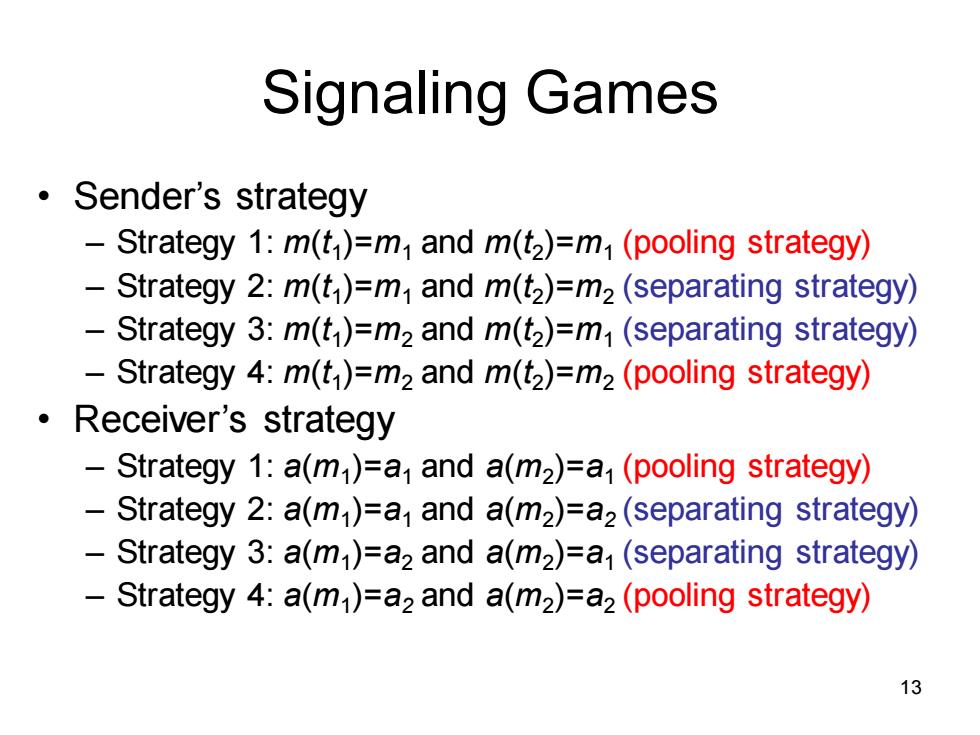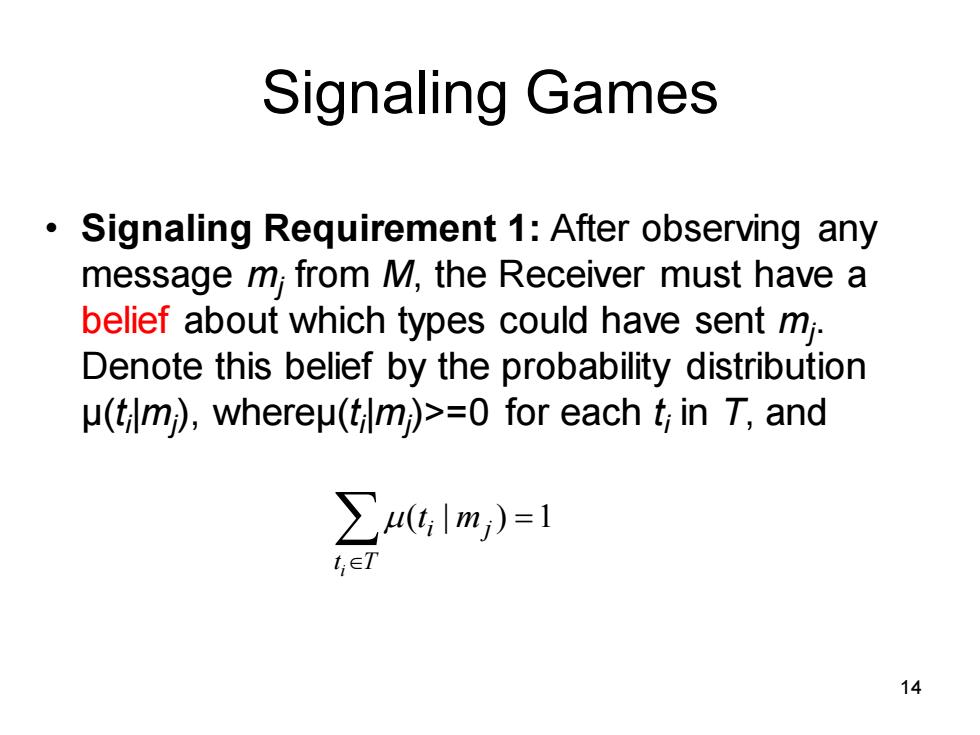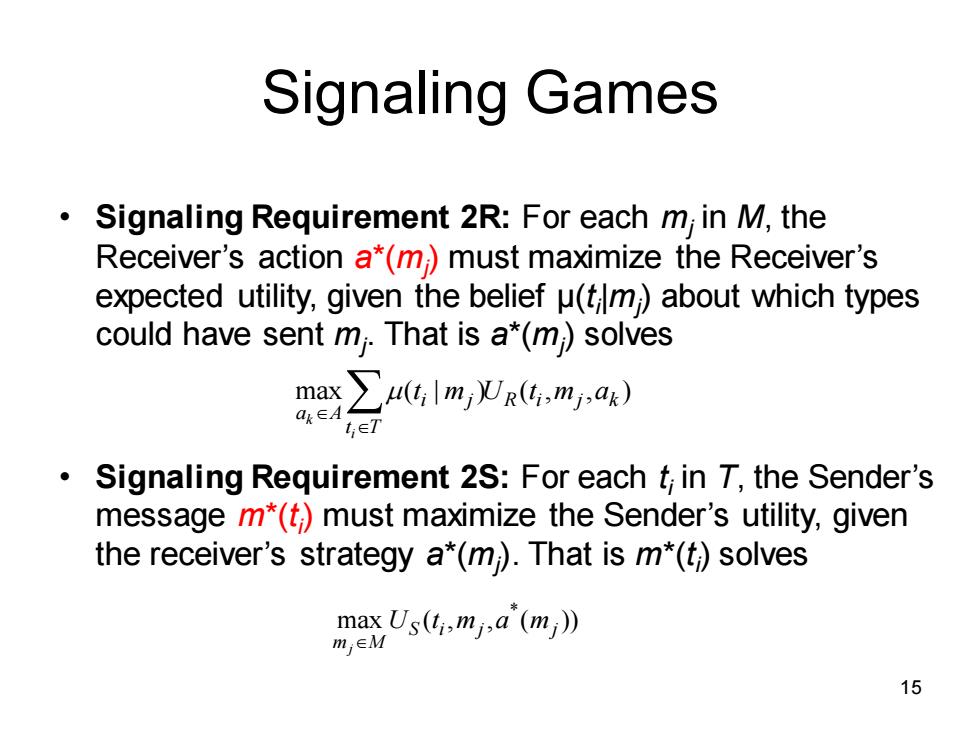
Signaling Games A pure strategy for the Sender is a function m(t)specifying which message will be chosen for each type that nature might draw A pure strategy for the Receiver -is a function a(m)specifying which action will be chosen for each message that the Sender might send. 11
Signaling Games • A pure strategy for the Sender – is a function m(t i ) specifying which message will be chosen for each type that nature might draw • A pure strategy for the Receiver – is a function a(mj ) specifying which action will be chosen for each message that the Sender might send. 11

Signaling Games:Example Sender m1 m2 a2 p 82 Receiver Nature Receiver a1 1-p mi tz m2 01 Sender a2 T=(t,t2),M=(m,m2),A=a,a2),and Prob(t)=p 12
Signaling Games: Example a1 a2 a1 a2 m1 m2 m1 m2 a1 a2 a2 a1 Nature p 1-p t1 t2 Sender Sender Receiver Receiver T={t1 ,t2 }, M={m1 ,m2 }, A={a1 ,a2 }, and Prob(t1 )=p 12

Signaling Games 。 Sender's strategy -Strategy 1:m(t)=m and m(t2)=m(pooling strategy) Strategy 2:m(t)=m and m(t2)=m2(separating strategy) Strategy 3:m(t)=m2 and m(t2)=m(separating strategy) -Strategy 4:m(t)=m2 and m(t2)=m2(pooling strategy) ·Receiver's strategy Strategy 1:a(m)=a and a(m2)=a(pooling strategy) Strategy 2:a(m)=a and a(m2)=a2(separating strategy) Strategy 3:a(m)=a2 and a(m2)=a1(separating strategy) -Strategy 4:a(m)=a2 and a(m2)=a2(pooling strategy) 13
Signaling Games • Sender’s strategy – Strategy 1: m(t1 )=m1 and m(t2 )=m1 (pooling strategy) – Strategy 2: m(t1 )=m1 and m(t2 )=m2 (separating strategy) – Strategy 3: m(t1 )=m2 and m(t2 )=m1 (separating strategy) – Strategy 4: m(t1 )=m2 and m(t2 )=m2 (pooling strategy) • Receiver’s strategy – Strategy 1: a(m1 )=a1 and a(m2 )=a1 (pooling strategy) – Strategy 2: a(m1 )=a1 and a(m2 )=a2 (separating strategy) – Strategy 3: a(m1 )=a2 and a(m2 )=a1 (separating strategy) – Strategy 4: a(m1 )=a2 and a(m2 )=a2 (pooling strategy) 13

Signaling Games Signaling Requirement 1:After observing any message m;from M,the Receiver must have a belief about which types could have sent mi. Denote this belief by the probability distribution u(m),whereu(tm)>=0 for each t;in T,and ∑44,m)=1 t 14
Signaling Games • Signaling Requirement 1: After observing any message mj from M, the Receiver must have a belief about which types could have sent mj . Denote this belief by the probability distribution μ(t i |mj ), whereμ(t i |mj )>=0 for each t i in T, and ( | ) 1 i i j t T t m = 14

Signaling Games Signaling Requirement 2R:For each m;in M,the Receiver's action a*(m )must maximize the Receiver's expected utility,given the belief u(m)about which types could have sent m;.That is a*(m)solves max∑44m,WR4,m,a) ak∈A Signaling Requirement 2S:For each t in T,the Sender's message m*(t)must maximize the Sender's utility,given the receiver's strategy a*(m).That is m*(t)solves maxUs(ti,mj,a (mj)) mj∈M 15
Signaling Games • Signaling Requirement 2R: For each mj in M, the Receiver’s action a*(mj ) must maximize the Receiver’s expected utility, given the belief μ(t i |mj ) about which types could have sent mj . That is a*(mj ) solves • Signaling Requirement 2S: For each t i in T, the Sender’s message m*(t i ) must maximize the Sender’s utility, given the receiver’s strategy a*(mj ). That is m*(t i ) solves max ( | ) ( , , ) k i i j R i j k a A t T t m U t m a * max ( , , ( )) j S i j j m M U t m a m 15